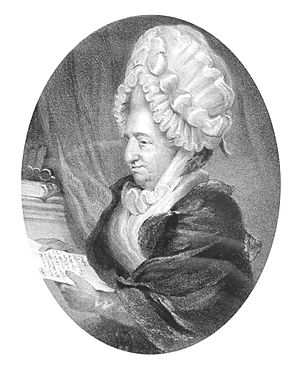Frances Boscawen facts for kids

Frances Evelyn "Fanny" Boscawen (born Glanville) lived from 1719 to 1805. She was an important English lady who loved books and talking about ideas. She was also a member of a famous group called the Blue Stockings Society. Frances was born in Kent, England. In 1742, she married Admiral Edward Boscawen. He was a navy officer. When his navy work took him away from home, Frances would send him parts of her journal. Some of these writings were later published.
Contents
Her Family
Frances and Edward Boscawen had several children. Here are some of them:
- Edward Hugh Boscawen (1744–1774)
- Frances Boscawen (1746–1801); she married Admiral John Leveson-Gower.
- Elizabeth Boscawen (1747–1828); she married the Duke of Beaufort. She might have been the "Lady in Blue" in a painting by Thomas Gainsborough.
- William Glanville Boscawen (1749–1769), who passed away when he was 19.
- George Boscawen (born 1758). He later became the 3rd Viscount Falmouth.
Important Connections
Frances's family was part of the aristocratic class. This means they were from important, well-known families. They were also connected to the royal courts of King George II and King George III. For example, her son-in-law, Henry Somerset, 5th Duke of Beaufort, worked for Queen Charlotte.
The Blue Stockings Society
After her husband, Edward Boscawen, passed away in 1761, Frances moved back to her home in London. There, she became a very important host for meetings of the Blue Stockings Society. This was a group of smart, educated women and men who met to discuss literature, art, and ideas. They were known for their intelligent conversations, not just for dancing or parties.
Famous Friends
Many famous people visited Frances's home. These included:
- Elizabeth Montagu, another important leader of the Bluestockings.
- Horace Walpole, a famous writer and art historian.
- Dr Johnson, a very well-known writer.
- Mrs Delany, an artist and botanist.
- Anna Letitia Barbauld, a poet and writer.
- James Boswell, who wrote a famous book about Dr Johnson.
- Joshua Reynolds, a famous painter who had painted her husband.
- Elizabeth Carter, a scholar and poet.
- Later, Hannah More, a writer who called Frances "sage" (meaning wise) in her poem The Bas Bleu.
Frances was known in London for writing excellent letters and for being a great conversationalist. People admired her for her quick wit, graceful manner, and kind heart.
Influence on the King
Frances even had some influence with King George III. She convinced him to ask the artist John Opie to paint a picture of her friend, Mrs Delany. This painting was so special that it hung in the king's own bedroom! The frame for the painting was designed by Horace Walpole. John Opie's wife, Amelia Opie, was also connected to the Blue Stockings Society. Frances's daughter, Elizabeth, Duchess of Beaufort, was also part of this fashionable group.
Frances Boscawen passed away at her home in London on February 26, 1805.

